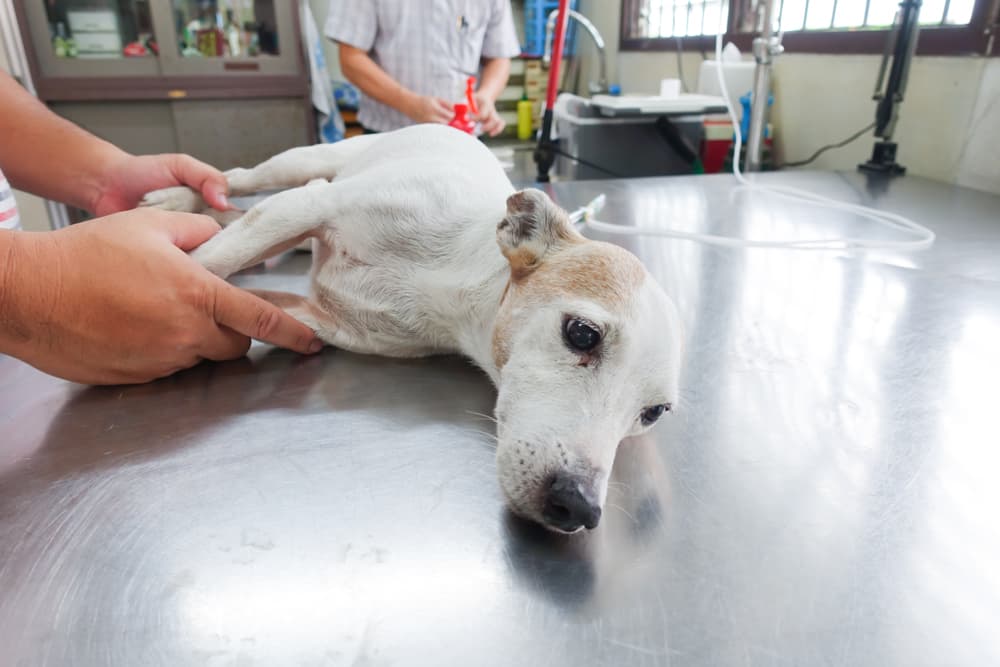Addison’s Disease in Dogs

Overview
- Addison's disease is caused by the dysfunction or destruction of the adrenal glands.
- Signs often don't show up until a dog is very sick.
- Collapse, pale gums, and seizures can signify Addison's disease in dogs.
- An Addisonian crisis in dogs can be fatal.
- Addison’s disease in dogs cannot be cured, but it can be managed with medicine if caught early.
Addison’s disease in dogs is scary because it seems to come on suddenly and severely. However, by the time your dog shows signs of being ill, more than 90 percent of the hormone-producing tissue in her two adrenal glands are non-functional.
Addison’s disease, also known as hypoadrenocorticism, is complicated to diagnose because it mimics the symptoms of many other canine diseases. Making things more difficult, the blood chemistry signs of the disease that your veterinarian looks for may not be present at first, even if your dog is already ill.
What is Addison’s Disease?
Addison’s disease is caused by the dysfunction or destruction of the adrenal glands in dogs. The adrenal glands are a pair of small hormone-producing organs located near the kidneys that produce corticosteroids, such as cortisol, and mineralocorticoids, such as aldosterone.
Cortisol is a hormone that helps a dog’s body cope with stress. This includes everyday stressors such as exercise and more severe stressors like injuries.
Aldosterone is a hormone that helps to regulate electrolytes, such as sodium and potassium, in a dog’s body. These electrolytes are involved in many important body functions including the maintenance of adequate body fluid.
A dog with Addison’s disease does not properly produce these adrenal hormones. Since hormones normally circulate throughout the body and have their effects everywhere, the entire body is affected by Addison’s disease. It can cause severe dehydration, coma, or even sudden death.
Occasionally, dogs with Addison’s disease will only have a deficiency in the production of corticosteroids. This is called atypical Addison’s disease. While atypical Addison’s disease can be more difficult to diagnose, it is generally easier to treat.
What Causes Addison’s Disease in Dogs?

The specific causes of Addison’s disease in dogs are not fully understood. The disease is caused by the destruction or dysfunction of the adrenal glands, which can happen due to an overactive immune system or as a secondary result of other diseases.
The cause of Addison’s disease in some dogs may also be idiopathic, meaning the cause cannot be pinpointed and remains unknown.
Middle-aged, female dogs are most likely to be diagnosed with Addison’s disease. Standard Poodles, Labrador Retrievers, Great Danes, Portuguese Water Dogs, West Highland Terriers, Rottweilers, and Nova Scotia Duck Tolling Retrievers are more likely than other dog breeds to be affected.
If your dog abruptly stops taking steroid medication this can cause a type of Addison’s disease. Though it can be severe, it is often curable. Always follow your veterinarian’s instructions to slowly decrease steroid medications over time.
Symptoms of Addison’s Disease in Dogs
Unfortunately, nearly one-third of dogs diagnosed with Addison’s disease are diagnosed because they get very sick, known as an Addisonian crisis. This is when dehydration becomes very severe and inadequate blood flow results.
Dogs may also have a dangerous imbalance in blood electrolytes resulting in abnormal heart function.
Symptoms of Addison’s disease in dogs include:
- Low energy – listlessness or lethargy, this sign may be intermittent
- Collapse – this is commonly the first sign of Addison’s Disease. Collapse may also be due to other serious conditions such as heart disease, neurologic defects, or epileptic diseases.
- Vomiting or regurgitation – this can be both acute (sudden) or chronic (long-term). It can be very difficult for pet owners to distinguish between vomiting and regurgitation.
- Diarrhea – this is a sign that your dog feels ill and is not specific to Addison’s disease.
- Seizures – seizures can result from very low blood sugar (hypoglycemia), a potential complication ofAddison’s disease.
- Pale gums – poor blood flow results in pale or muddy looking gums.
- Low heart rate – due to an imbalance in electrolytes in the blood, the heart rate may become so low that it results in collapse or sudden death.
An Addisonian crisis in dogs can be fatal. Dogs in this situation may be in an extreme state that includes low blood pressure, low blood sugar, and a slow heart rate. Each of these are very serious and should be treated in the hospital by your veterinarian.
A dog in an Addisonian crisis will require hospitalization that may cost $500-$1000 per day or more as doctors and their staff work to save your pet.
Diagnosing Your Dog With Addison’s Disease

Diagnosis of Addison’s disease requires general and specific tests. As with any disease in our pets, the first step is a complete physical exam. Dogs with undiagnosed Addison’s disease often arrive at the veterinary hospital quite ill and a physical exam is important in determining what is wrong.
Your veterinarian will perform a complete blood count (CBC), chemistry panel including electrolyte levels, and urinalysis. These are tests of general body function. Dogs with Addison’s disease have an imbalance in their electrolyte levels as well as possible abnormalities in kidney values. Normally, a sick dog will have elevated white blood cells but this response is absent in dogs with Addison’s disease.
Next, if your veterinarian is suspicious of Addison’s disease, she will recommend an ACTH stimulation test. ACTH is a hormone produced by the pituitary gland that signals to the adrenal gland to release steroids. If blood steroid levels do not respond to this injection, your dog has Addison’s disease.
An abdominal ultrasound can also be helpful for diagnosis. The adrenal glands, normally small organs, are shrunken in dogs with Addison’s disease. An abdominal ultrasound can also rule out other causes of illness such as cancer.
A full set of diagnostic tests costs between $600 and $2,000, depending on which tests are required.
How to Treat Addison’s Disease in Dogs
Addison’s disease in dogs cannot be cured, but it can be managed with medicine. When starting medication, your veterinarian will recommend frequent blood tests to make sure the medicine is working properly.
Once your pet’s disease is well-regulated, blood testing may be recommended every 3-6 months ($100-$250 per testing).
Dogs with well-controlled Addison’s disease can have a normal life. However, left untreated Addison’s disease is fatal.
Medication for Addison’s Disease in Dogs
There are two types of medicines for treating Addison’s disease, the cost of which is dependent on the size of your dog. The first is a pill called fludrocortisone.
Fludrocortisone: This is a pill that needs to be given every 12-24 hours. Depending on the size of your dog, it costs $50-$200 per month. Over years, your dog’s dose will increase.
Desoxycorticosterone Pivalate (DOCP) Injection: This is an injection given approximately every 25 days. Your veterinarian will check your dog’s electrolyte levels before the first several of these injections and then every 3-6 months. The injections cost approximately $100-$300 each.
Your dog may also need to be given low-dose oral prednisone. Prednisone tablets are inexpensive, usually approximately $10-$20 per month. The exact dosing regimen depends on your dog and your lifestyle. Talk about the exact dosing expectations with your veterinarian.
How to Prevent Addison’s Disease

Unfortunately, there is no way to prevent Addison’s disease in dogs. If you have an at-risk breed, be sure to ask your breeder whether there is a family history of Addison’s disease and other diseases common to that breed.
If your pet is taking steroid medications such as prednisone, do not abruptly stop them. Steroids should be tapered over the course of several days to weeks, following your veterinarian’s recommendations.
Related Conditions
- Megaesophagus
- Diabetes mellitus
- Urinary tract infections
- Renal Failure
- Whipworm infection
- Syncope
- Epilepsy
- Cushing’s Disease









